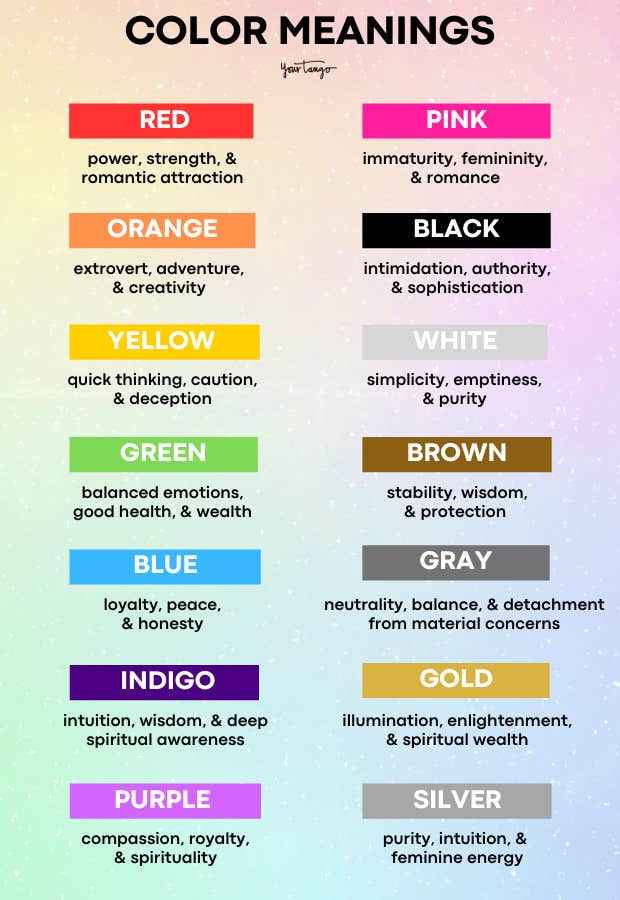14 Popular Colors & The Spiritual Meaning Of Each
What does your favorite color mean?
 Casther, funbutterfly / Shutterstock
Casther, funbutterfly / Shutterstock Colors are so prevalent in our daily lives that sometimes we barely even notice them or think of their spiritual meaning.
We notice the color of our outfits, the colors that represent our battery life, and the color of traffic signals, but outside of those things, colors usually fade to the back of our minds.
What does each color mean, and what makes them spiritual?
Each color has its own spiritual symbols. Every shade evokes certain emotions out of different people.
Color and emotions are closely linked. Colors that are warm impact us differently than colors that are cool.
Every color is unique in its own way outside of how light or dark they are, how good they look against our skin tone, or whether or not we think they are nice.
Warm Colors vs Cool Colors
The Spiritual Meaning of Warm Colors
Warm colors tend to make us think of things that are warm such as sunlight or heat. Colors that fall under the warm category are red, orange, yellow, and combinations of these colors.
Warm colors are used to make large spaces seem cozier and more intimate than they actually are.
Warm colors are associated with heightened emotions. They are intense and they bring forth joy, playfulness, and happiness.
Warm colors are good for rooms that will have a lot of activity because they are known to stimulate.
The Spiritual Meaning of Cool Colors
Cool colors tend to calm and soothe us. These colors remind us of snow, water, and the sky. Some examples of cool colors are blue, light purple, and green.
Cool colors tend to make small, intimate spaces appear as much more spacious as they actually are.
Cool colors bring about calm, relaxed, and refreshing feelings.
Cool colors are good for places that you go to unwind such as your bedroom or your restroom.
Colors can also impact temperature.
If you live in a place where it is hot most of the time, decorating your home with warm colors will make it even hotter. It would be a good idea to decorate with cool colors because it will cool down the heat coming from outdoors.
If you live in a place where it is cold most of the time, it would be smart to decorate your home with warm colors. Decorating with warm colors will make your home a little less chilly.
Other than being warm or cool, every color has its own deeper meaning that it is known for.
Here's what each color means, and the spiritual symbolism for each.
The Spiritual Meaning of the Color Red
Red is known for representing passion. Red can be associated with power, strength, and romantic attraction. It is also sometimes associated with anger and rage.
Because of traffic signals and signs, the color red represents stop or is used as a warning. Red easily catches our attention because of how bright it is and the way that it stands out against other colors.
The Spiritual Meaning of the Color Orange
Orange is known as the color of the extrovert. It is associated with adventure and creativity, and is also used to draw attention and uplift moods.
Orange is a blend of red and yellow, giving it a lot of energy and warmth.
The color orange can also be associated with superficiality and impatience. It triggers hunger, and foods that are orange are often nutritious.
The Spiritual Meaning of the Color Yellow
Yellow, the color of sunshine, stimulates the left side of the brain, causes quick thinking, and reduces indecisiveness. It is known to boost moods and increase energy, and can also symbolize caution and deception.
Yellow is not a good color for marketing because it typically fades into the background. Although it is bright, it is not noticeable against other light colors.
The Spiritual Meaning of the Color Green
The color green balances emotions and is a symbol of good health and wealth. It has the ability to revitalize and balance as well as increase luck. Green is also associated with envy and materialism.
This color is a natural healer, so many pharmaceuticals use it when advertising products. The connection between the color green and good health is commonly made, but many often do not notice that this color makes them feel safe and hopeful.
The Spiritual Meaning of the Color Blue
Blue represents loyalty, peace, and honesty. It is used for relaxation and protection, but can also be associated with sadness and passiveness.
Blue subtly makes itself known by bringing tranquility. When we are overwhelmed, blue helps us to decompress and remain calm. The color is a peacemaker and is against stirring up conflict.
The Spiritual Meaning of the Color Indigo
Indigo is the color of intuition, wisdom, and deep spiritual awareness. It is considered a powerful and mystical hue, representing the connection between the physical and spiritual realms.
It encourages introspection and opens the mind to higher levels of consciousness. Indigo is also a symbol of spiritual growth and enlightenment.
The Spiritual Meaning of the Color Purple
Purple is the color of royalty and spirituality. It creates fantasies and encourages us to confront our deepest thoughts. It is associated with compassion and creativity but also can symbolize immaturity and sensitivity.
Purple has a powerful presence and can be an intimidating color.

The Spiritual Meaning of the Color Pink
Pink often represents femininity and romance. It makes us feel accepted and nurtures us. Pink can also be associated with immaturity and lack of confidence.
Pink embodies all things good in the world and is not meant to threaten or intimidate.
The Spiritual Meaning of the Color Black
The color black exudes authority and sophistication. Black can also be associated with depression and pessimism.
It is often seen at formal events and is considered to be sexy and sleek. Black has no intention to intimidate, but because of its darkness, it causes many negative feelings.
The Spiritual Meaning of the Color White
White represents purity. It is associated with simplicity and perfection, and makes others feel good by providing them with clarity and renewal.
White can also be associated with emptiness and distance. It makes people feel appreciated and valued.
The Spiritual Meaning of the Color Brown
Brown is the color of stability. The color brown is full of wisdom and encourages an appreciation for all of life’s small treasures.
Although it is sometimes considered dull or boring, the color brown gives support and protection when it is needed the most.
The Spiritual Meaning of the Color Gray
Gray is commonly linked to neutrality, balance, and detachment from material concerns.
Gray is seen as a color of compromise and wisdom, as it combines the qualities of black and white. It symbolizes the middle ground between light and darkness.
The color gray invites individuals to find harmony and peace amidst life's complexities, and fosters a sense of stability and resilience in spiritual pursuits.
The Spiritual Meaning of the Color Gold
Gold is the color of illumination, enlightenment, and spiritual wealth.
It represents divine guidance, higher consciousness, and the pursuit of spiritual transformation and awakening. It symbolizes a connection to the divine, inner wisdom, and the attainment of spiritual knowledge and understanding.
In many cultures, gold has been revered as a sacred color, signifying the highest and most cherished spiritual truths.
The Spiritual Meaning of the Color Silver
The color silver is often linked to purity, intuition, and feminine energy.
Silver symbolizes a strong connection with the moon and its cycles, making it associated with intuition and psychic abilities. It represents a state of reflection and self-discovery, encouraging individuals to explore their inner world and embrace their intuitive nature.
Silver's spiritual significance also includes qualities such as emotional balance, adaptability, and a sense of mystery and enchantment.
Sarah Jones-Smith is a writer who covers romance, relationships, and the daily lives of women. Her work has been featured in NFL Network, Andscape, and Seattle Medium.

